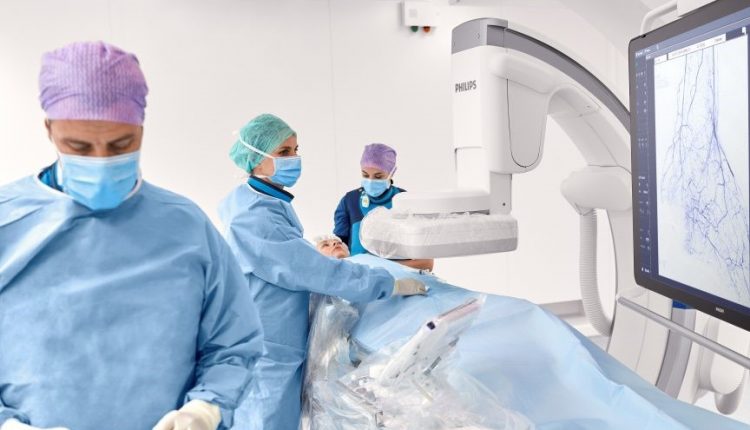
Angioplasty and stenting of the lower limbs: what it is, how it is performed and what outcomes it has
Lower limb angioplasty and stenting are interventional radiology procedures used to treat the occlusion of an arterial blood vessel, allowing adequate blood flow to be restored. It is a non-invasive procedure which is performed via catheter without the need for surgery
What is Angioplasty and Stenting of the Lower Limbs?
Lower limb angioplasty and stenting are interventional radiology procedures used to treat the occlusion of an arterial blood vessel.
Reconstruction of the damaged blood vessel can be performed by inflating a balloon in order to restore the lumen of the vessel and allow adequate revascularisation (angioplasty).
Reconstruction can be completed with the insertion of a stent, a cylindrical metal prosthesis inserted into the stenotic segment of the narrowed blood vessel to keep the lumen of the treated vessel open.
It is a non-invasive procedure performed using catheters introduced under radiological monitoring, without having to perform a classic “open” surgery, but through a percutaneous puncture.
How is lower limb angioplasty and stenting performed?
The procedure is performed under sterile conditions in the angiography room.
The puncture site is generally the right groin, where local anaesthesia is performed.
A catheter is advanced under radiological monitoring to the blood vessel affected by the narrowing or occlusion.
Contrast medium is injected at this location to visualise the distribution of the blood vessels and the presence of any lesions (including narrowings and occlusions).
Reconstruction of the damaged blood vessel can be performed by inserting a catheter with an inflatable balloon that is pushed up to the point of narrowing and inflated to dilate the lumen of the narrowed vessel (it may be necessary to inflate the balloon more than once) and allow adequate revascularisation.
Alternatively, a stent – a metal prosthesis inserted into the stenotic segment of the blood vessel via a catheter – can be inserted to restore its calibre and allow adequate revascularisation.
The procedure takes about an hour and a half and requires the written consent of the patient.
What are the benefits of Angioplasty and stenting of the lower limbs?
This type of procedure restores the normal calibre of the diseased (narrowed or occluded) vessel to allow blood flow to return to as close to normal as possible.
The risks of this procedure include:
– bleeding or bruising that may occur around the area of the incision through which the catheter was inserted;
– very rarely a blood clot may block the blood supply to the treated vascular district or the artery wall may be weakened (in many cases this problem can be treated by the radiologist at the same angioplasty session, but sometimes surgery may be necessary);
– in very rare cases, there may be a reaction to the contrast medium. Possible serious complications include sudden occlusion of the artery and the formation of a new stenosis.
Is angioplasty and stenting of the lower limbs dangerous or painful?
This procedure is minimally invasive and quite safe.
The patient may experience a little discomfort when injecting the local anaesthetic into the skin at the groin level.
The introduction of the catheter into the artery does not cause any pain.
A slight pressure or discomfort may be felt when the balloon is inflated inside the narrowed or occluded blood vessel.
Which patients are eligible for lower limb angioplasty and stenting?
Suitability for treatment is discussed with the patient at the interventional radiology specialist visit after specific diagnostic tests, such as echo-colour Doppler and CT angiography of the lower limbs.
The doctor may also consider it inappropriate to perform the procedure on patients suffering from coagulation disorders, hypercoagulability, blood vessel disease or total occlusion.
Follow-up
After undergoing treatment for angioplasty and stenting of the lower limbs, the patient should remain in bed for a period of 12 to 24 hours.
Discharge usually takes place no earlier than the day after the operation.
Aspirin treatment is often prescribed at discharge to avoid the risk of thrombosis.
Smokers should stop smoking and overweight people should improve their diet by reducing their cholesterol and saturated fat intake.
Finally, after angioplasty and stenting it is a good idea to increase the amount of physical exercise and to do it regularly.
Are there any preparation rules?
Admission is usually on the day before the procedure.
Once admitted, the patient will need to take antiplatelet medication to prepare for the procedure.
If you are on other medications, you should discuss with your doctor whether you should continue with your current medication.
Read Also:
Emergency Live Even More…Live: Download The New Free App Of Your Newspaper For IOS And Android
Carotid Angioplasty And Stenting: What Are We Talking About?
Coronary Angioplasty, What To Do Post-Operatively?
Heart Patients And Heat: Cardiologist’s Advice For A Safe Summer
US EMS Rescuers To Be Assisted By Paediatricians Through Virtual Reality (VR)
Coronary Angioplasty, How Is The Procedure Performed?



